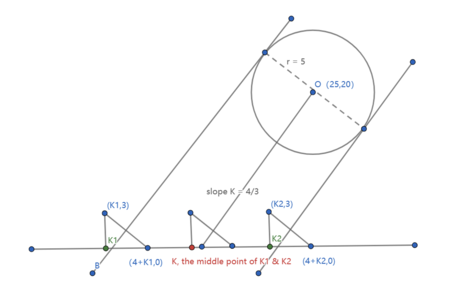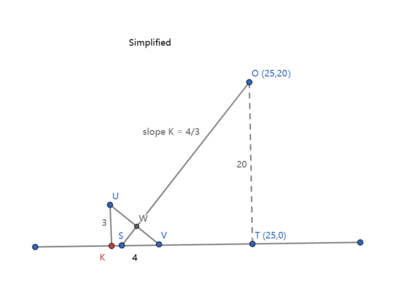2025 AIME I Problems/Problem 8
Contents
Problem
Let ![]() be a real number such that the system
\begin{align*}
&|25 + 20i - z| = 5 \\
&|z - 4 - k| = |z - 3i - k|
\end{align*}
has exactly one complex solution
be a real number such that the system
\begin{align*}
&|25 + 20i - z| = 5 \\
&|z - 4 - k| = |z - 3i - k|
\end{align*}
has exactly one complex solution ![]() . The sum of all possible values of
. The sum of all possible values of ![]() can be written as
can be written as ![]() , where
, where ![]() and
and ![]() are relatively prime positive integers. Find
are relatively prime positive integers. Find ![]() . Here
. Here ![]() .
.
Video solution by grogg007
https://youtu.be/wib5vos7Sd4?t=268
Solution 1
![[asy] size(300); draw((0, 0) -- (0, 20), EndArrow(10)); label("$y$", (0, 20), NW); dot((25,20)); draw((0, 0) -- (25, 0), EndArrow(10)); label("$x$", (25, 0), SE); draw(circle((25,20),5)); label(scale(0.7)*"$(25,20)$", (25,20), S); draw((7,0) -- (3,3), blue); draw((5,3/2) -- (21,23), dashed); label("$(4+k,0)$", (7,0), S); label("$(k,3)$", (3,3), N); draw(rightanglemark((3,3),(5,3/2),(21,23), 20)); draw(rightanglemark((25,20),(21,23),(5,3/2), 20)); draw((25,20) -- (21,23)); [/asy]](http://latex.artofproblemsolving.com/5/5/b/55b4293d356e1004283f0668760ab19ef31280a5.png) The complex number
The complex number ![]() must satisfy the following conditions on the complex plane:
must satisfy the following conditions on the complex plane:
![]() The magnitude between
The magnitude between ![]() and
and ![]() is
is ![]() This can be represented by drawing a circle with center
This can be represented by drawing a circle with center ![]() and radius
and radius ![]()
![]() It is equidistant from the points
It is equidistant from the points ![]() and
and ![]() Hence it must lie on the perpendicular bisector of the line connecting these points.
Hence it must lie on the perpendicular bisector of the line connecting these points.
For ![]() to have one solution, the perpendicular bisector of the segment connecting the two points must be tangent to the circle.
This bisector must pass the midpoint,
to have one solution, the perpendicular bisector of the segment connecting the two points must be tangent to the circle.
This bisector must pass the midpoint, ![]() and have slope
and have slope ![]() The segment connecting the point of tangency to the center of the circle has slope
The segment connecting the point of tangency to the center of the circle has slope ![]() meaning the points of tangency can be
meaning the points of tangency can be ![]() or
or ![]() Solving the equation for the slope of the perpendicular bisector gives
Solving the equation for the slope of the perpendicular bisector gives ![]() or
or ![]() giving
giving ![]() or
or ![]() , having a sum of
, having a sum of ![]()
~nevergonnagiveup
Solution 2 (Systematic + Algebra)
We first look at each equation, and we convert each to algebra (note that the absolute value sign of ![]() means the magnitude). Let's convert z to
means the magnitude). Let's convert z to ![]() .
.
Note that the first equation becomes:
![]()
Note that this is the equation of a circle centered at ![]() with radius
with radius ![]() .
.
And the second equation becomes:
![]()
You can see that the many similar terms that cancel out, simplfying, you get:
![]()
Now we must isolate B
![]()
![]()
This equation can be seen as a line with a ![]() slope, and a y-intercept of
slope, and a y-intercept of ![]() .
.
Note that the question only wants one solution, so we want two tangent lines, one above the circle, and one below the circle. You can see Solution 2 for the picture.
Because the slope is ![]() , the circle must have a slope coming out of center of its reciprocal,
, the circle must have a slope coming out of center of its reciprocal, ![]() . So the points on the circle where this line with a
. So the points on the circle where this line with a ![]() must intersect must be
must intersect must be ![]() and
and ![]() . We can easily use point-slope form to find the equations of these lines.
. We can easily use point-slope form to find the equations of these lines.
![]()
and
![]()
Now we must match the y-intercepts to the equations with ![]() in it.
Solving the equations:
in it.
Solving the equations:
![]()
![]()
we get that ![]() and
and ![]() Adding them up and simplifying, we get a sum of
Adding them up and simplifying, we get a sum of ![]()
~Marcus :)
Solution 3 (A Little Geometry)
To solve the problem, we first locate the point ![]() . According to the conditions, we can know that:
. According to the conditions, we can know that:
![]() is on the perpendicular bisector of
is on the perpendicular bisector of ![]() and
and ![]()
The distance from ![]() to circle
to circle ![]() is
is ![]() .
.
Therefore, ![]() must be the 2 points of tangent of a line with the slope of
must be the 2 points of tangent of a line with the slope of ![]() with circle O (center at
with circle O (center at ![]() , radius of
, radius of ![]() ), corresponding to the 2 values:
), corresponding to the 2 values: ![]() and
and ![]() .
.
Since the question only asks for the sum of ![]() and
and ![]() , we would not need to calculate them separately. Let the middle point of
, we would not need to calculate them separately. Let the middle point of ![]() and
and ![]() be
be ![]() ==>
==> ![]() +
+ ![]() =
= ![]() .
.
Looking at the simplified figure below. We may calculate using similarity of the triangles:
![]()
![]()
![]()
![]()
![]()
We conclude that ![]() .
.
~cassphe
Solution 4 (Distance Formula, quick)
Let ![]() Then the system becomes
Then the system becomes ![]() and
and ![]()
![]() . For this system to have one solution for
. For this system to have one solution for ![]() the line
the line ![]() must be tangent to the circle
must be tangent to the circle ![]() . For a line to be tangent to a circle, the distance between the line and center must be equal to the length of the radius, which is
. For a line to be tangent to a circle, the distance between the line and center must be equal to the length of the radius, which is ![]() . The center of the circle is
. The center of the circle is ![]() and we can express the line as
and we can express the line as ![]() So we have:
So we have: ![]()
![]()
![]() is
is ![]() The requested sum is
The requested sum is ![]()
~grogg007, Mathycoder & MathKing555 also previously mentioned a similar approach
See also
| 2025 AIME I (Problems • Answer Key • Resources) | ||
| Preceded by Problem 7 |
Followed by Problem 9 | |
| 1 • 2 • 3 • 4 • 5 • 6 • 7 • 8 • 9 • 10 • 11 • 12 • 13 • 14 • 15 | ||
| All AIME Problems and Solutions | ||
These problems are copyrighted © by the Mathematical Association of America, as part of the American Mathematics Competitions. ![]()











